Tailoring Nonlinear Metamaterials for the Controlling of Spatial Quantum Entanglement
Abstract
:1. Introduction
2. Materials and Methods
3. Results
4. Conclusions
Author Contributions
Funding
Institutional Review Board Statement
Informed Consent Statement
Data Availability Statement
Conflicts of Interest
References
- Su, V.C.; Chu, C.H.; Sun, G.; Tsai, D.P. Advances in optical metasurfaces: Fabrication and applications. Opt. Express 2018, 26, 13148–13182. [Google Scholar] [CrossRef] [PubMed]
- Karnieli, A.; Roitman, D.; Liebtrau, M.; Tsesses, S.; van Nielen, N.; Kaminer, I.; Arie, A.; Polman, A. Cylindrical metalens for generation and focusing of free-electron radiation. Nano Lett. 2022, 22, 5641–5650. [Google Scholar] [CrossRef] [PubMed]
- Yang, Z.; Kuang, D. Visible-broadband localized vector vortex beam generator with a multi-structure-composited meta-surface. Nanomaterials 2019, 9, 166. [Google Scholar] [CrossRef] [PubMed] [Green Version]
- Ming, Y.; Intaravanne, Y.; Ahmed, H.; Kenney, M.; Lu, Y.Q.; Chen, X. Creating composite vortex beams with a single geometric metasurface. Adv. Mater. 2022, 34, 2109714. [Google Scholar] [CrossRef] [PubMed]
- Huidobro, P.A.; Maier, S.A.; Pendry, J.B. Tunable plasmonic metasurface for perfect absorption. EPJ Appl. Metamat. 2017, 4, 6. [Google Scholar] [CrossRef] [Green Version]
- Wu, L.; Chen, Y. Three-stage quantum cryptography protocol under collective-rotation noise. Entropy 2015, 17, 2919–2931. [Google Scholar] [CrossRef] [Green Version]
- Brown, K.L.; Munro, W.J.; Kendon, V.M. Using quantum computers for quantum simulation. Entropy 2010, 12, 2268–2307. [Google Scholar] [CrossRef] [Green Version]
- Giovannetti, V.; Lloyd, S.; Maccone, L. Advances in quantum metrology. Nat. Photonics 2011, 5, 222–229. [Google Scholar] [CrossRef] [Green Version]
- Shih, Y.H. Entangled photons. IEEE J. Sel. Top. Quantum Electron. 2003, 9, 1455–1467. [Google Scholar] [CrossRef]
- Ming, Y.; Wu, Z.J.; Cui, G.X.; Tan, A.H.; Xu, F.; Lu, Y.Q. Integrated source of tunable nonmaximally mode-entangled photons in a domain-engineered lithium niobate waveguide. Appl. Phys. Lett. 2014, 104, 171110. [Google Scholar] [CrossRef]
- Kwiat, P.G.; Mattle, K.; Weinfurter, H.; Zeilinger, A.; Sergienko, A.V.; Shih, Y.H. New high-intensity source of polarization-entangled photon pairs. Phys. Rev. Lett. 1995, 75, 4337–4341. [Google Scholar] [CrossRef] [Green Version]
- Leng, H.Y.; Yu, X.Q.; Gong, Y.X.; Xu, P.; Xie, Z.D.; Jin, H.; Zhang, C.; Zhu, S.N. On-chip steering of entangled photons in nonlinear photonic crystals. Nat. Commun. 2011, 2, 429. [Google Scholar] [CrossRef] [PubMed] [Green Version]
- Ming, Y.; Tan, A.H.; Wu, Z.J.; Chen, Z.X.; Xu, F.; Lu, Y.Q. Tailoring entanglement through domain engineering in a lithium niobate waveguide. Sci. Rep. 2014, 4, 4812. [Google Scholar] [CrossRef] [PubMed] [Green Version]
- Ming, Y.; Zhang, W.; Tang, J.; Liu, Y.; Xia, Z.L.; Liu, Y.S.; Lu, Y.Q. Photonic entanglement based on nonlinear metamaterials. Laser Photonics Rev. 2020, 14, 1900146. [Google Scholar] [CrossRef]
- Ni, J.; Huang, C.; Zhou, L.M.; Gu, M.; Song, Q.; Kivshar, Y.; Qiu, C.W. Multidimensional phase singularities in nanophotonics. Science 2021, 374, eabj0039. [Google Scholar] [CrossRef] [PubMed]
- Santiago-Cruz, T.; Fedotova, A.; Sultanov, V.; Weissflog, M.A.; Arslan, D.; Younesi, M.; Pertsch, T.; Staude, I.; Setzpfandt, F.; Chekhova, M. Photon pairs from resonant metasurfaces. Nano Lett. 2021, 21, 4423–4429. [Google Scholar] [CrossRef]
- Santiago-Cruz, T.; Gennaro, S.D.; Mitrofanov, O.; Addamane, S.; Reno, J.; Brener, I.; Chekhova, M.V. Resonant metasurfaces for generating complex quantum states. Science 2022, 377, 991–995. [Google Scholar] [CrossRef]
- Lapine, M.; Shadrivov, I.V.; Kivshar, Y.S. Colloquium: Nonlinear metamaterials. Rev. Mod. Phys. 2014, 86, 1093–1123. [Google Scholar] [CrossRef] [Green Version]
- Liu, Y.; Chen, W.; Zhang, W.; Ma, C.Q.; Chen, H.X.; Xiong, Y.F.; Yuan, R.; Tang, J.; Chen, P.; Hu, W.; et al. Visible and online detection of near-infrared optical vortices via nonlinear photonic crystals. Adv. Opt. Mater. 2022, 10, 2101098. [Google Scholar] [CrossRef]
- Keren-Zur, S.; Avayu, O.; Michaeli, L.; Ellenbogen, T. Nonlinear beam shaping with plasmonic metasurfaces. ACS Photonics 2016, 3, 117–123. [Google Scholar] [CrossRef]
- Li, G.X.; Wu, L.; Li, K.F.; Chen, S.M.; Schlickriede, C.; Xu, Z.J.; Huang, S.Y.; Li, W.D.; Liu, Y.J.; Pun, E.Y.B.; et al. Nonlinear metasurface for simultaneous control of spin and orbital angular momentum in second harmonic generation. Nano Lett. 2017, 17, 7974–7979. [Google Scholar] [CrossRef] [PubMed]
- Schlickriede, C.; Waterman, N.; Reineke, B.; Georgi, P.; Li, G.X.; Zhang, S.; Zentgraf, T. Imaging through nonlinear metalens using second harmonic generation. Adv. Mater. 2018, 30, 1703843. [Google Scholar] [CrossRef] [PubMed] [Green Version]
- Liu, N.; Guo, H.; Fu, L.; Kaiser, S.; Schweizer, H.; Giessen, H. Three-dimensional photonic metamaterials at optical frequencies. Nat. Mater. 2008, 7, 31–37. [Google Scholar] [CrossRef]
- Segal, N.; Keren-Zur, S.; Hendler, N.; Ellenbogen, T. Controlling light with metamaterial-based nonlinear photonic crystals. Nat. Photonics 2015, 9, 180–184. [Google Scholar] [CrossRef]
- Loot, A.; Hizhnyakov, V. Modeling of enhanced spontaneous parametric down-conversion in plasmonic and dielectric structures with realistic waves. J. Opt. 2018, 20, 055502. [Google Scholar] [CrossRef]
- Leonhardt, U. Quantum statistics of a lossless beam splitter: SU (2) symmetry in phase space. Phys. Rev. A 1993, 48, 3265–3277. [Google Scholar] [CrossRef]
- Poddubny, A.N.; Iorsh, I.V.; Sukhorukov, A.A. Generation of photon-plasmon quantum states in nonlinear hyperbolic metamaterials. Phys. Rev. Lett. 2016, 117, 123901. [Google Scholar] [CrossRef] [PubMed] [Green Version]
- Antonosyan, D.A.; Solntsev, A.S.; Sukhorukov, A.A. Effect of loss on photon-pair generation in nonlinear waveguide arrays. Phys. Rev. A 2014, 90, 043845. [Google Scholar] [CrossRef] [Green Version]
- Ming, Y.; Zhang, W.H.; Chen, Z.X.; Wu, Z.J.; Tang, J.; Xu, F.; Zhang, L.J.; Lu, Y.Q. Squeezing a surface plasmon through quadratic nonlinear interactions. ACS Photonics 2016, 3, 2074–2082. [Google Scholar] [CrossRef]
- Qin, Y.Q.; Zhang, C.; Zhu, Y.Y.; Hu, X.P.; Zhao, G. Wave-front engineering by Huygens-Fresnel principle for nonlinear optical interactions in domain engineered structures. Phys. Rev. Lett. 2008, 100, 063902. [Google Scholar] [CrossRef]
- Loudon, R. The Quantum Theory of Light, 3rd ed.; Oxford University Press: New York, NY, USA, 2000. [Google Scholar]
- Allen, L.; Beijersbergen, M.W.; Spreeuw, R.J.C.; Woerdman, J.P. Orbital angular momentum of light and the transformation of Laguerre-Gaussian laser modes. Phys. Rev. A 1992, 45, 8185–8189. [Google Scholar] [CrossRef]
- Mair, A.; Vaziri, A.; Weihs, G.; Zeilinger, A. Entanglement of the orbital angular momentum states of photons. Nature 2001, 412, 313–316. [Google Scholar] [CrossRef] [PubMed] [Green Version]
- Burns, W.K.; Bloembergen, N. Third-harmonic generation in absorbing media of cubic or isotropic symmetry. Phys. Rev. B 1971, 4, 3437–3450. [Google Scholar] [CrossRef]
- Li, G.X.; Chen, S.M.; Pholchai, N.; Reineke, B.; Wong, P.W.H.; Pun, E.Y.B.; Cheah, K.W.; Zentgraf, T.; Zhang, S. Continuous control of the nonlinearity phase for harmonic generations. Nat. Mater. 2015, 14, 607–612. [Google Scholar] [CrossRef] [PubMed] [Green Version]
- Miatto, F.M.; di Lorenzo Pires, H.; Barnett, S.M.; van Exter, M.P. Spatial Schmidt modes generated in parametric down-conversion. Eur. Phys. J. D 2012, 66, 263. [Google Scholar] [CrossRef] [Green Version]
- Lu, L.L.; Xu, P.; Zhong, M.L.; Bai, Y.F.; Zhu, S.N. Orbital angular momentum entanglement via fork-poling nonlinear photonic crystals. Opt. Express 2015, 23, 1203–1212. [Google Scholar] [CrossRef]
- Kante, B.; Park, Y.S.; O’Brien, K.; Shuldman, D.; Lanzillotti-Kimura, N.D.; Wong, Z.J.; Yin, X.B.; Zhang, X. Symmetry breaking and optical negative index of closed nanorings. Nat. Commun. 2012, 3, 1180. [Google Scholar] [CrossRef] [Green Version]
- Tseng, M.L.; Wu, P.C.; Sun, S.; Chang, C.M.; Chen, W.T.; Chu, C.H.; Chen, P.L.; Zhou, L.; Huang, D.W.; Yen, T.J.; et al. Fabrication of multilayer metamaterials by femtosecond laser-induced forward-transfer technique. Laser Photonics Rev. 2012, 6, 702–707. [Google Scholar] [CrossRef]
- Shen, K.C.; Huang, Y.T.; Chung, T.L.; Tseng, M.L.; Tsai, W.Y.; Sun, G.; Tsai, D.P. Giant efficiency of visible second-harmonic light by an all-dielectric multiple-quantum-well metasurface. Phys. Rev. Appl. 2019, 12, 064056. [Google Scholar] [CrossRef]
- Qian, H.; Li, S.; Chen, C.F.; Hsu, S.W.; Bopp, S.E.; Ma, Q.; Tao, A.R.; Liu, Z. Large optical nonlinearity enabled by coupled metallic quantum wells. Light Sci. Appl. 2019, 8, 13. [Google Scholar] [CrossRef]
- Ming, Y.; Zhang, W.; Tang, J.; Yang, X.; Liu, Y.S.; Lu, Y.Q. Nonlinear wavy metasurfaces with topological defects for manipulating orbital angular momentum states. ACS Photonics 2021, 8, 1896–1902. [Google Scholar] [CrossRef]
- Wang, S.M.; Mu, S.Y.; Zhu, C.; Gong, Y.X.; Xu, P.; Liu, H.; Li, T.; Zhu, S.N.; Zhang, X. Hong-Ou-Mandel interference mediated by the magnetic plasmon waves in a three-dimensional optical metamaterial. Opt. Express 2012, 20, 5213–5218. [Google Scholar] [CrossRef] [PubMed] [Green Version]
- Pan, J.W.; Chen, Z.B.; Lu, C.Y.; Weinfurter, H.; Zeilinger, A.; Zukowski, M. Multiphoton entanglement and interferometry. Rev. Mod. Phys. 2012, 84, 777–838. [Google Scholar] [CrossRef]
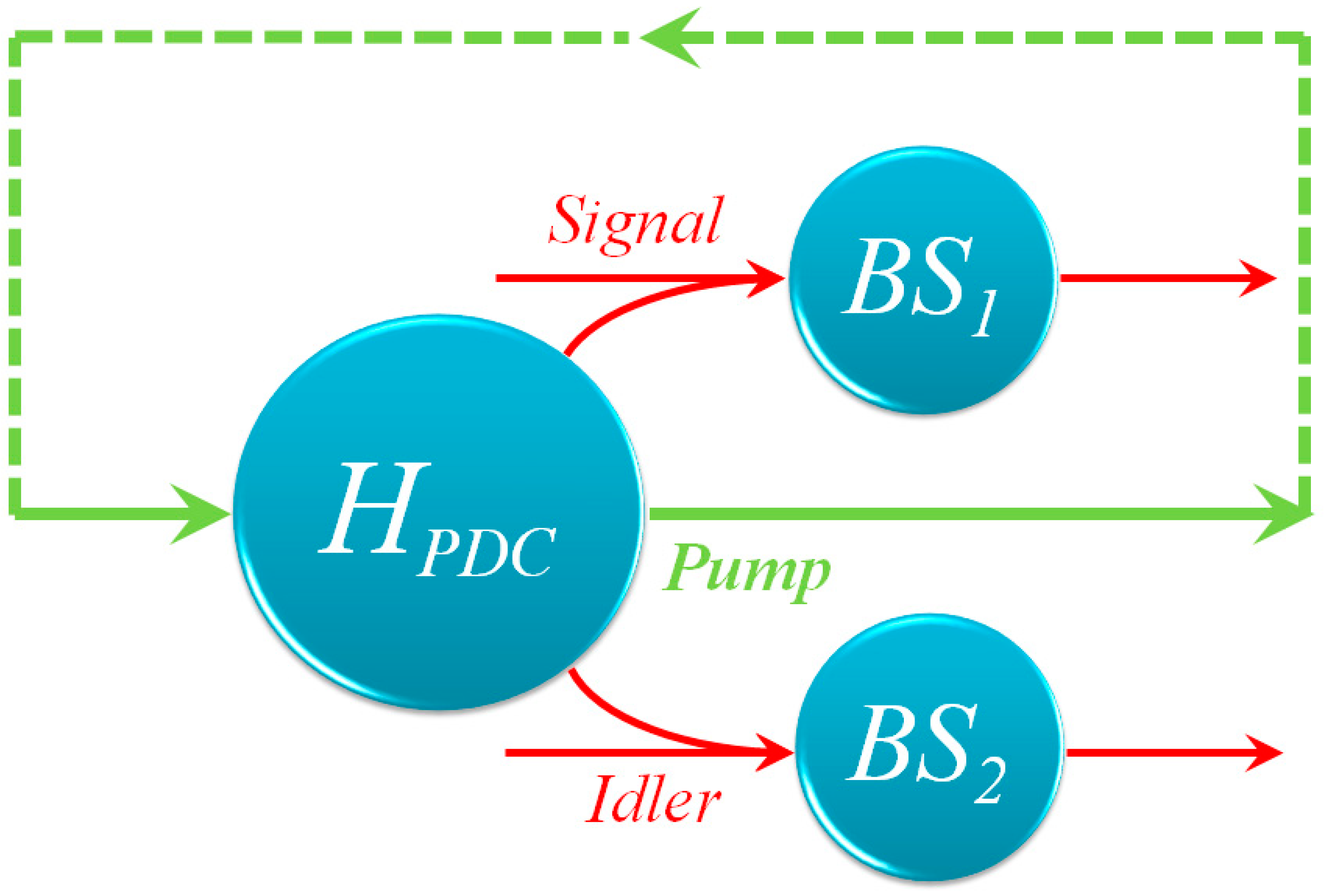
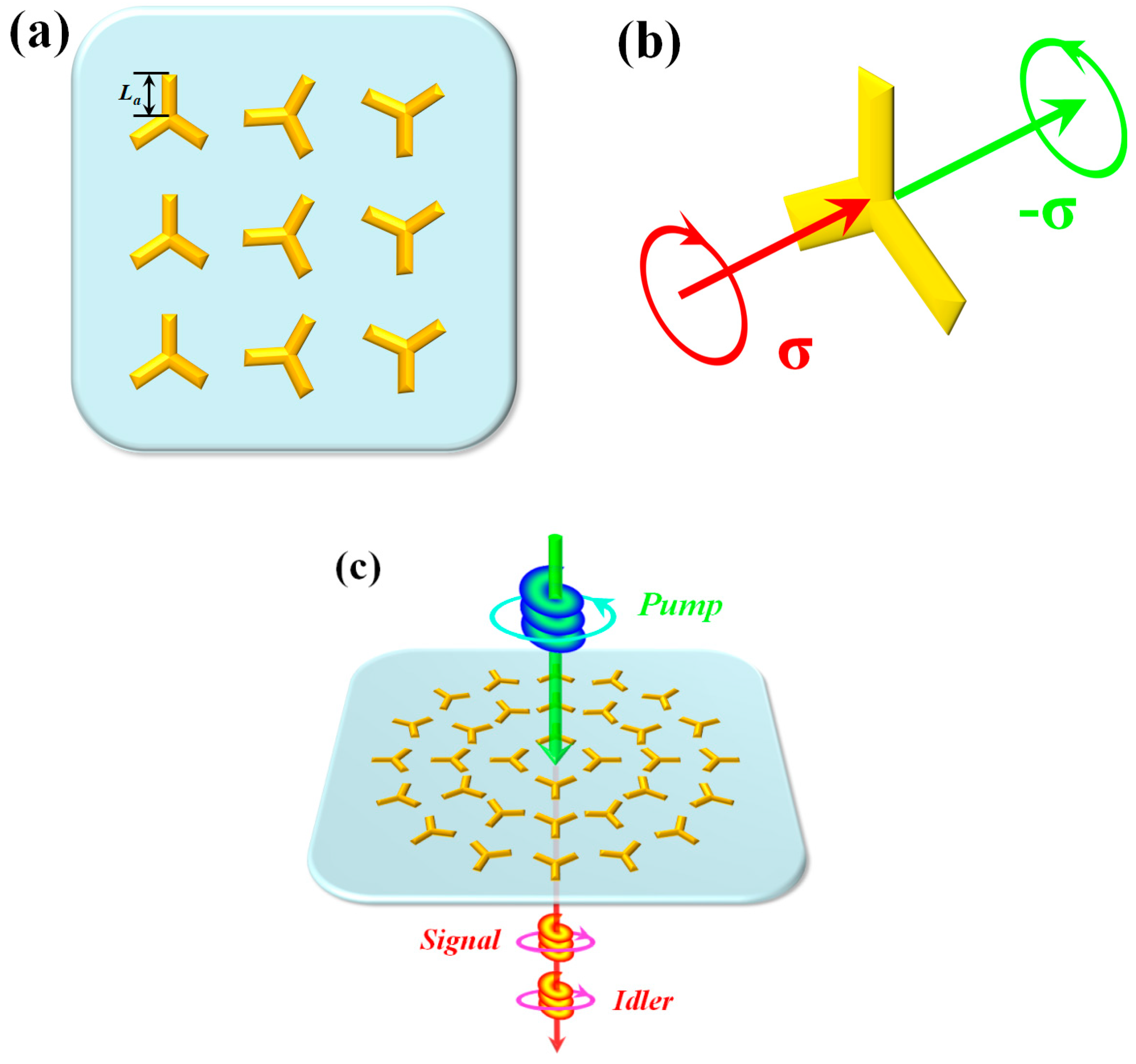
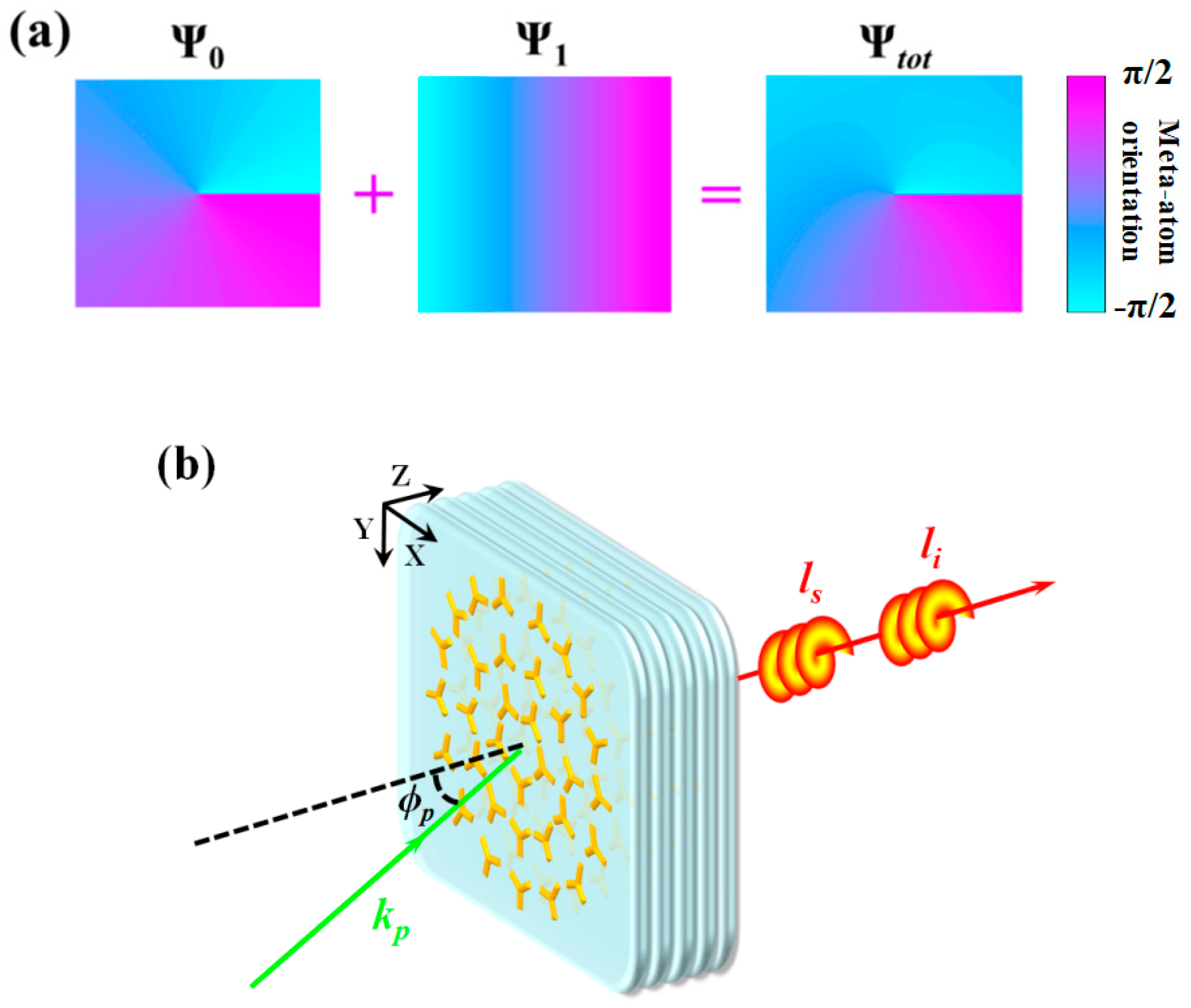
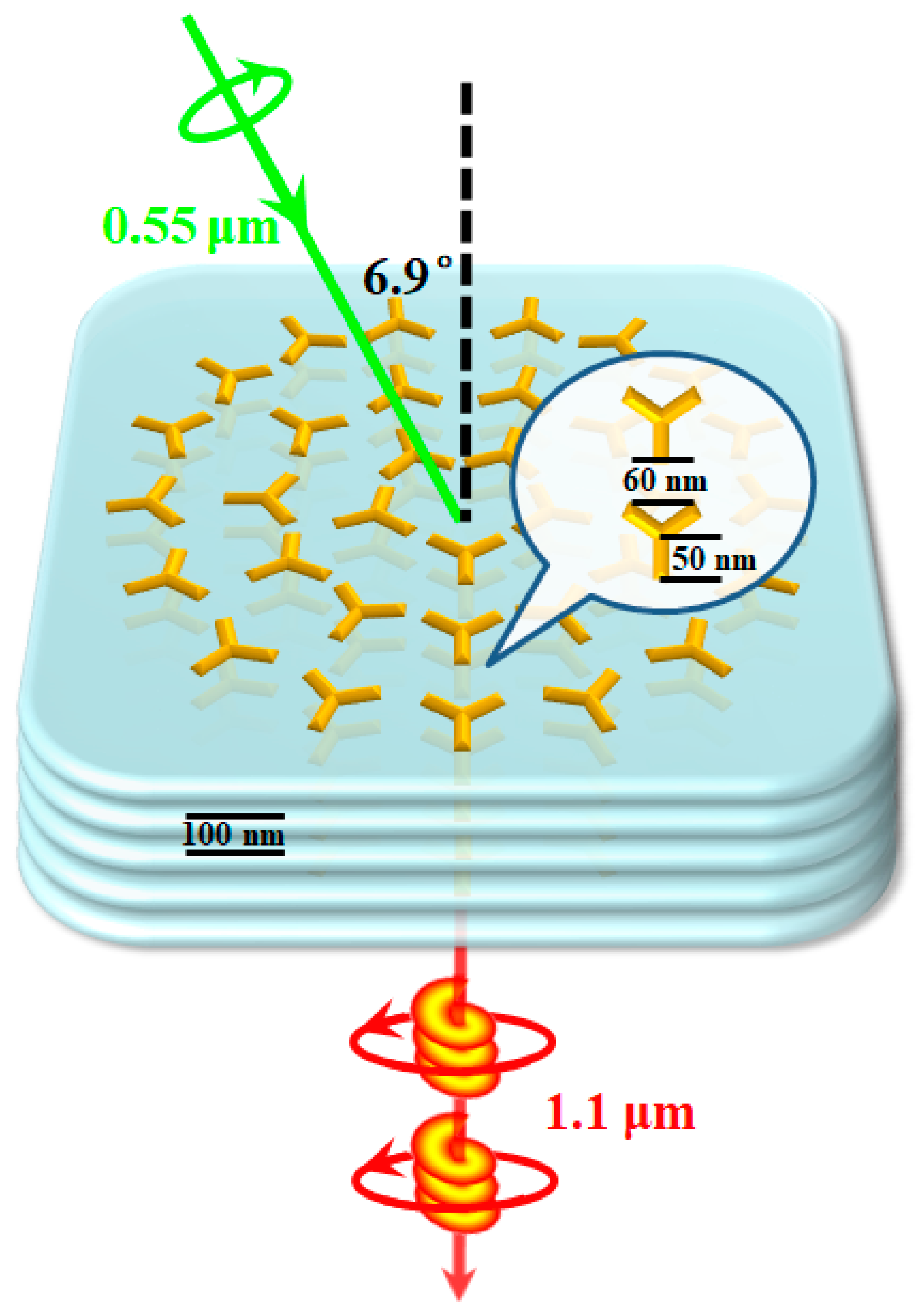
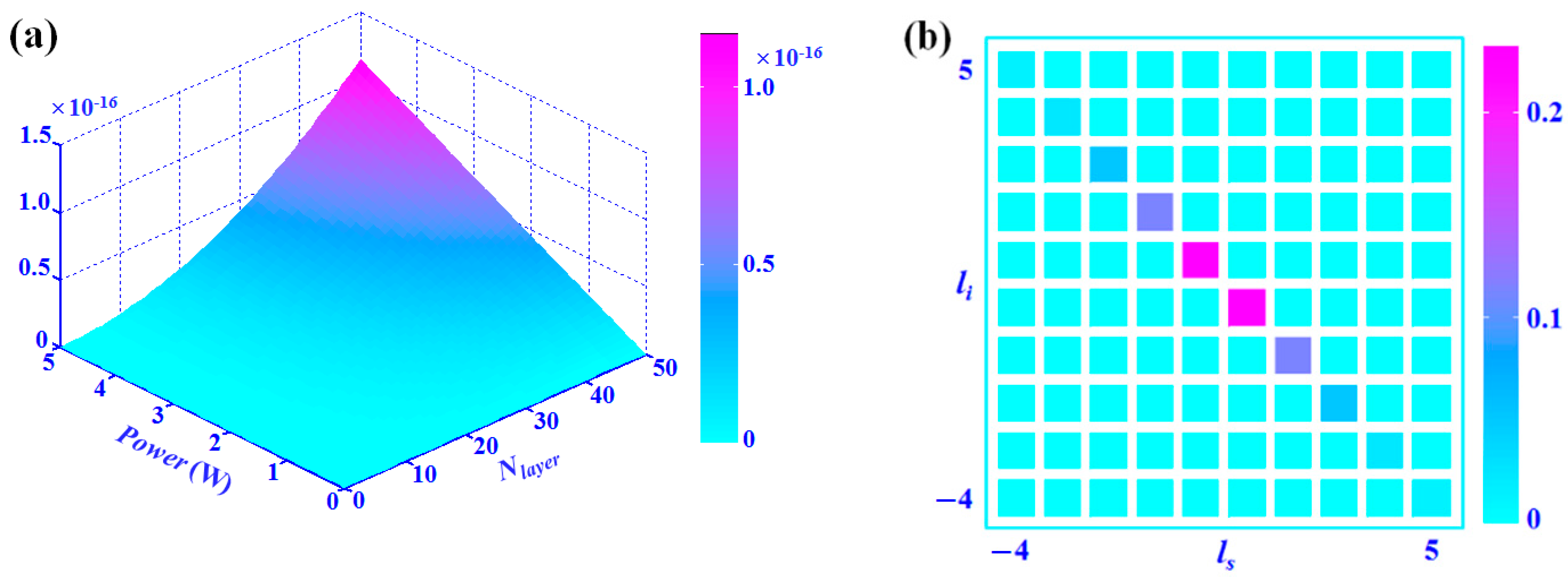
Publisher’s Note: MDPI stays neutral with regard to jurisdictional claims in published maps and institutional affiliations. |
© 2022 by the authors. Licensee MDPI, Basel, Switzerland. This article is an open access article distributed under the terms and conditions of the Creative Commons Attribution (CC BY) license (https://creativecommons.org/licenses/by/4.0/).
Share and Cite
Ming, Y.; Liu, Y.; Chen, W.; Yan, Y.; Zhang, H. Tailoring Nonlinear Metamaterials for the Controlling of Spatial Quantum Entanglement. Nanomaterials 2022, 12, 4001. https://doi.org/10.3390/nano12224001
Ming Y, Liu Y, Chen W, Yan Y, Zhang H. Tailoring Nonlinear Metamaterials for the Controlling of Spatial Quantum Entanglement. Nanomaterials. 2022; 12(22):4001. https://doi.org/10.3390/nano12224001
Chicago/Turabian StyleMing, Yang, Yuan Liu, Wei Chen, Yusen Yan, and Huiguo Zhang. 2022. "Tailoring Nonlinear Metamaterials for the Controlling of Spatial Quantum Entanglement" Nanomaterials 12, no. 22: 4001. https://doi.org/10.3390/nano12224001
APA StyleMing, Y., Liu, Y., Chen, W., Yan, Y., & Zhang, H. (2022). Tailoring Nonlinear Metamaterials for the Controlling of Spatial Quantum Entanglement. Nanomaterials, 12(22), 4001. https://doi.org/10.3390/nano12224001





